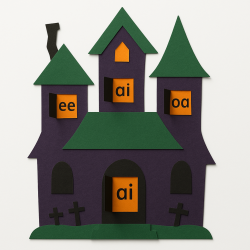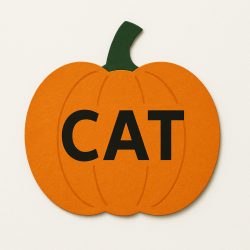Autumnal Phonics Activities for Key Stage One
Introduction
The autumn season offers a brilliant backdrop for engaging Key Stage One pupils with fun, seasonal activities that make learning both memorable and enjoyable. This collection of activities is carefully designed to balance creativity with structured literacy learning.
With clear curriculum links such as Phase 5 alternative graphemes and Year 1 National Curriculum objectives, each activity is both innovative and educational. By using these resources, teachers can build a strong foundation in phonics while celebrating the charm of autumn.
-
Haunted House Word Building
The Haunted House Word Building activity utilises a specially designed template featuring windows and doors that display various graphemes, for example, ee, ai, and oa.
This visually stimulating resource helps children familiarise themselves with specific grapheme patterns in a fun and engaging way. The use of a haunted house setting adds an element of excitement, making the learning process both interactive and memorable.
In this activity, pupils actively participate by opening doors, reading the displayed graphemes, and then constructing words such as 'spook', 'moon', and 'ghost'.

This playful method reinforces Phase 5 alternative graphemes, providing a creative twist to traditional word-building exercises. The experience not only enhances word recognition but also bolsters the overall literacy skills in a thematic and enjoyable manner.
-
Monster Rhyming Challenge
The Monster Rhyming Challenge introduces an element of surprise with monster cards that feature words like bat, frog, and light. Children are tasked with finding or writing down rhyming words, adding a competitive aspect to the activity. This challenge is designed to reinforce phoneme-grapheme correspondence and sharpen the pupils' listening skills while having fun.
Teachers can adapt the challenge by including either simple CVC words or more complex vowel digraphs to suit varying learning needs. This flexibility ensures that all pupils, regardless of their current abilities, can participate and benefit from the task. The activity thereby enhances rhyme awareness and solidifies essential spelling patterns through a creative, monster-themed approach.
-
Pumpkin Patch Sentence Building
The Pumpkin Patch Sentence Building activity utilises pumpkins word cards that feature both tricky words and decodable words. This engaging exercise enables children to mix and match words, encouraging them to form coherent sentences with a festive twist. By combining seasonal imagery with literacy tasks, this activity captures the imagination and makes sentence construction an interactive experience.

A sample sentence such as 'The big cat sat on the pumpkin' illustrates how simple, descriptive language can be built up using these resources. The task is closely linked to Year 1 National Curriculum objectives, ensuring that the phonics skills developed during the exercise are directly applicable to established literacy goals. This method provides a clear framework for both creative expression and structured learning in early writing.
-
Spooky Sound Sorting
The Spooky Sound Sorting activity challenges pupils to organise autumnal words by their spelling patterns, for instance, grouping words like 'moon', 'broom', and 'room' to highlight the long /oo/ sound. This exercise not only enforces sound patterns but also enhances vocabulary through the use of thematic, seasonal words. Children engage in a hands-on, tactile learning experience that promotes both spelling accuracy and auditory discrimination.
By incorporating Halloween vocabulary such as 'web', 'spell', 'ghost', and 'night', the activity further deepens their phoneme-grapheme awareness. This structured sorting task ties directly into Year 1/2 phoneme-grapheme correspondences and spelling rules, making it a valuable addition to any literacy lesson. The thematic grouping of words also aids in memory retention and reinforces a systematic approach to learning spelling patterns.
-
Witches Spelling Potions
The Witches Spelling Potions activity employs ingredient cards that display graphemes like igh, ee, and ar, which children then combine to form words that resemble magical spells. As they create their own 'spells', pupils record these words in a mini 'spelling spell book', which serves as a delightful keepsake of their learning journey. This engaging task not only consolidates phonics and spelling skills but also nurtures a sense of wonder and creativity in the classroom.
-
Autumn Harvest Tricky Word Bingo
This activity transforms the classic game of bingo into a literacy task by using boards filled with tricky and common exception words. Children actively listen as the teacher calls out words, marking them on their boards using acorns, conkers, or even mini pumpkins. The game is designed to build fluency in recognising common exception words, thereby strengthening the foundations of reading and writing for Year 1 and Year 2 pupils.
Integrating These Activities into Your Literacy Curriculum
Embedding these interactive autumnal activities into the existing literacy curriculum ensures that learning remains both dynamic and relevant. Teachers can plan lessons that are closely aligned with seasonal themes while targeting specific phonics and literacy objectives, thus creating a seamless connection between fun and structured education. This integrated approach not only maintains pupil engagement but also reinforces essential curriculum standards through carefully designed tasks.
Moreover, these activities can be adapted to meet the varying needs of diverse learners by modifying the level of difficulty or providing additional support as necessary. Regular monitoring and assessment will help ensure that every pupil makes measurable progress in their phonics and spelling skills. Such strategies guarantee that the classroom environment is both inclusive and effective.
